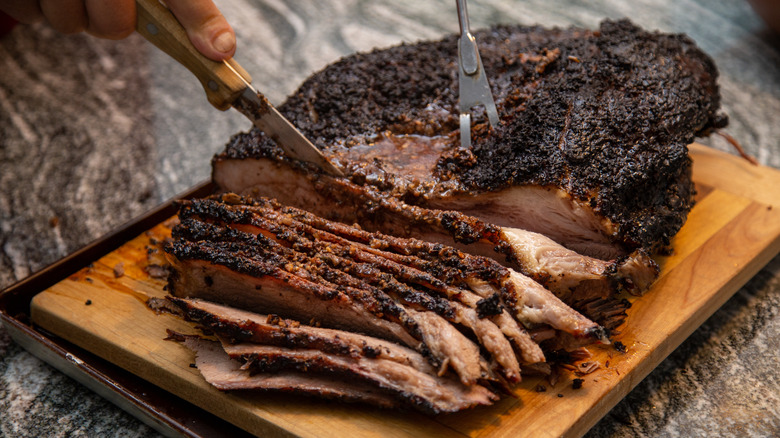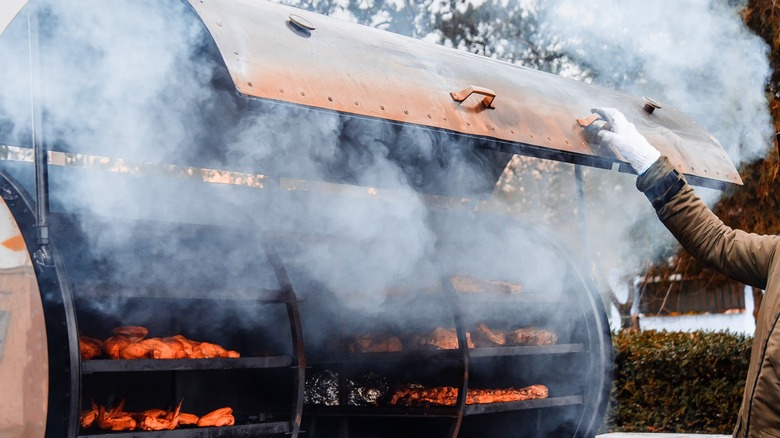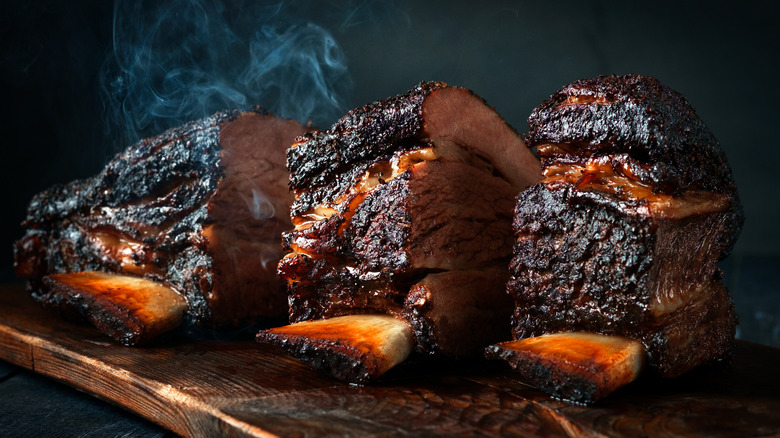The Best Type Of Wood To Use For Smoking Brisket
Preparing food over an open fire has long been an important part of human life — smoking meat is so ancient a practice that we can trace it all the way back to the Paleolithic period when humans dwelled in caves. But just because this cooking method predates any country or cuisine doesn't mean it's an intuitive practice or an innate skill for chefs today. And the careful nuance at work in properly smoking a delicious brisket perfectly illustrates that.
For those new to the world of smoking, it's easy to assume that smoking is just a means of transforming raw meat into cooked meat. In actuality, the smoke itself is an ingredient in the recipe, and each type of wood has a unique personality and characteristics that bring about different qualities in the finished product. A beginner may not know the flavor profile of mesquite wood and what to pair with it, for example. Or that, when smoking brisket, you want to use a very dry, cured wood that will give you good temperature control and prevent over-smoking the meat. As the preferred wood in Central Texas – where smoked brisket reigns supreme – you know post oak has to be a good option. Of course, plenty of others produce delicious results, too.
Why dry wood is essential for smoking
It's important to consider the final product you want to create when choosing the variety of wood you'll use to smoke your brisket. But no matter which flavors or characteristics you're hoping to impart during the smoking process, making sure you're using thoroughly dry wood is paramount. This is because wet wood introduces steam to your smoking environment, and steam will cause the established temperature to fluctuate. This will increase your cooking time and result in an over-smoked brisket — definitely not the flavor you're looking for.
So you want to make sure your wood is no longer green, meaning it's had enough time to season and dry out after being cut from a living tree. Green wood has a much higher moisture level than you want when smoking a brisket. Not only will this moisture skew your smoking temperature, but it can also leave a bitter taste behind since green wood also releases sap as it's burned. Green wood needs between six months and a year to achieve the appropriate level of moisture for smoking, which is around 20%. You also want to ensure you're using untreated, food-safe wood to avoid any unnecessary health risks.
Which wood varietals are best for brisket
Although post oak is most popular for smoking brisket in Central Texas, beloved for its low production of soot and the light smoky flavor it gives the meat, there are many other options at your disposal. Understanding the flavor that each imparts will help you choose the right one for the task at hand.
If you want your brisket to have more smoky flavor than post oak will provide, consider using hickory instead. Not only does this wood burn similarly to post oak, but you won't need to use as much of it as you would with other woods since its flavor is so strong. Hickory gives the meat a rich, intensely smoky flavor with a touch of sweetness and nutty notes. If you prefer to scale back on the intensity of your smoke, however, consider a fruit wood, like cherry or apple. While these won't make your brisket taste like the fruit their trees produce, they do create a less intense smoke that has a delicate fruity aroma. You can also mix the wood you use to reap the benefits of each. For example, adding a bit of hickory to your cherry wood will give you more control over the intensity of your finished brisket's overall smokiness while also offering a more complex, well-rounded flavor. Pair your finished barbecue brisket with cowboy butter to elevate its taste even further.



